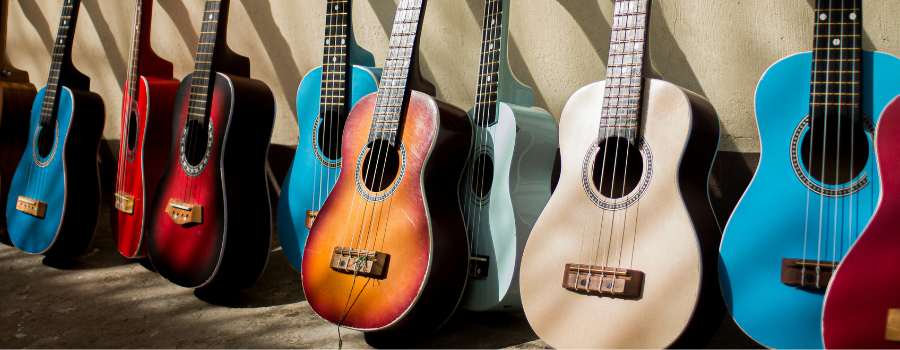
The wood used in the crafting of an acoustic guitar plays a significant role in determining its overall tone and sound quality. The type of wood used for the top, back, and sides of the guitar all contribute to the unique tonal characteristics of the instrument.
Different woods have varying densities, rigidity, and resonant properties, which affect how the guitar vibrates and projects sound. For example, a guitar with a spruce top will have a different tone than one with a cedar top.
In this article, I wanted to explore the various types of wood used in acoustic guitar construction and their tonal characteristics, to help you understand how each wood affects the sound of the guitar.
What Types of Wood Are Used To Build Acoustic Guitars?
The most common woods used in acoustic guitar construction include spruce, mahogany, rosewood, and cedar. Acoustic guitars use various types of wood in order to bring out unique tonal characteristics and visual appeal.
It’s worth noting that there are different species of each type of wood and that using different species may result in a different tonal characteristics, and suitability for different genres of music. Therefore, understanding the tonal characteristics of different woods is important when choosing an acoustic guitar or building one.
Below I’ll go into detail about some of the common wood used in construction and give examples of tonal characteristics as well as popular guitar brands made of these woods.
⦁ Spruce
⦁ Mahogany
⦁ Rosewood
⦁ Cedar
⦁ Other (Maple, Koa, Ovangkol)
Spruce
Spruce is lightweight and has excellent sound transmission properties, making it an ideal choice for the soundboard of an acoustic guitar. The soundboard is responsible for amplifying the vibrations of the strings and projecting sound out of the guitar.

Spruce has a bright and balanced tonal characteristic, which is known for its clarity and defined notes. It also has a good projection and sustain that makes it suitable for different styles of music such as folk, pop, and rock.
Tonal characteristics of Spruce:
⦁ Bright and balanced
⦁ Clear and defined notes
⦁ Good projection and sustain
There are various species of spruce that are used in acoustic guitar construction, each with slightly different timbre and tone:
| Spruce Species | Description |
| Sitka | Most common and versatile, used in all genres of music |
| Engelmann | Similar to Sitka but with a warmer, more rounded tone |
| Adirondack | Produces a louder and stronger tone, used for Bluegrass music |
Some examples of guitars with spruce top are Martin D-28, Taylor GS Mini, and Gibson J-45 Standard. It’s worth mentioning that the choice of spruce species may result in a different tonal characteristics and suitability for different genres of music, this is why it’s important to consider the type of music you play when choosing the type of spruce.
Mahogany
Mahogany is a popular choice for the back and sides of acoustic guitars because of its warm and rich tonal characteristics. It provides a well-rounded and smooth sound that complements the bright and balanced sound of a spruce top.
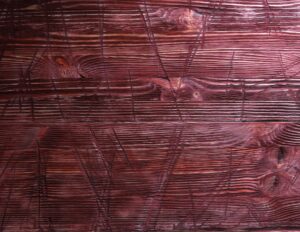
Mahogany is known for its good projection and balance, which is essential in providing the overall tonal quality of the guitar.
Tonal characteristics of Mahogany:
- Warm and rich
- Well-rounded and smooth
- Good projection and balance
There are different species of mahogany that are used in acoustic guitar construction, each with slightly different tonal characteristics.
| Mahogany Species | Description |
| Honduran Mahogany | Most common, known for its warmth and complexity |
| African Mahogany | Similar to Honduran but with a more pronounced low-end and less midrange |
| East Indian Mahogany | More stiff and dense than other types, good for projection and balance |
Different guitar models will offer different musical experiences due to their construction. For mahogany lovers, iconic guitars like the Gibson J-200, Martin D-18, and Taylor 214ce DLX provide distinctly rich tones that suit many genres of music…ranging from blues to folk and beyond!
Rosewood
Rosewood is a wood that is commonly used for the back and sides of acoustic guitars. It is known for its balance, richness, and warmth in its tonal characteristics. Rosewood is a dense wood which gives it a good projection and sustain. It’s often used to complement the bright and balanced sound of a spruce top.
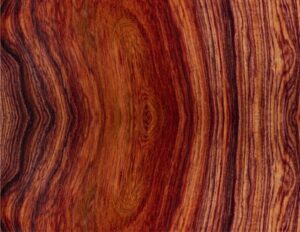
From the mellow warmth of Brazilian Rosewood to the bright resonance of Honduran, acoustic guitar builders have a range of rosewoods with unique tonal characters at their fingertips.
Tonal characteristics of Rosewood:
- Balanced and rich
- Warm and complex
- Good projection and sustain
Each species creates its own distinct voice for players to explore and discover:
| Rosewood Species | Description |
| Brazilian Rosewood | Considered the best for its rich and complex tone, but is restricted by CITES regulations |
| Indian Rosewood | Most commonly used, known for its balance and warmth |
| East Indian Rosewood | Similar to Indian but with a more pronounced low-end and less midrange |
Rosewood is a popular choice for guitars and it’s easy to see why! Whether you’re playing Rock, Country or Blues, Gibson J-200s, Martin D-28s or Taylor 814ces will lend their unique tone to your sound. But beyond the style of guitar being used, even the specific species of rosewood can make an impact on how your music sounds…making these instruments incredibly versatile options when seeking out just the right timbre.
Cedar
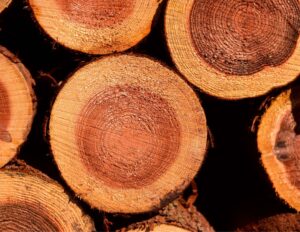
Cedar is an alternative wood to spruce that is used for the top of acoustic guitars. It’s known for its warmth and responsiveness which makes it particularly good for fingerstyle and classical music. The tone of a cedar top guitar is generally less bright and less defined than a spruce top, but it is considered to be mellower and warmer.
Tonal characteristics of Cedar:
- Warm and responsive
- Mellow and less defined than spruce
- Good for fingerstyle and classical music
There are two species of cedar that are commonly used in acoustic guitar construction, Western Red Cedar and Alaskan Yellow Cedar.
| Cedar Species | Description |
| Western Red Cedar | Most commonly used for its warmth and responsiveness |
| Alaskan Yellow Cedar | Less common but produces a more defined and brighter tone |
Guitar aficionados know that cedar tops can offer a unique tonal quality to your favorite stringed instrument. For example, the tone of the Cordoba C5-CE provides excellent balance for rock or jazz pieces, while Martin HD-28 is better suited for traditional music styles and Taylor GS Mini-e Bass works wonders with blues tunes. Ultimately, it’s important to keep in mind that different varieties of cedar may present distinct characteristics when you’re searching out just what sound best suits your style!
What Other Woods Are Used In Crafting Acoustic Guitars?
Maple, Koa, and Ovangkol are other popular woods that are used in the construction of acoustic guitars. Each are known for their unique tonal characteristics and are suitable for different playing styles.
- Maple – Bright, crisp, and articulate tone. It’s well suited for fingerstyle and country music.
- Koa – Bright, warm, and balanced tone that’s suitable for fingerstyle, pop, and rock music.
- Ovangkol – Bright, warm, and complex tone that makes it ideal for fingerstyle and jazz music.
With the sonic potential of less common woods, guitars such as Collings OM1 (Maple), Kamaka HF-3 (Koa) and Godin 5th Avenue Kingpin (Ovangkol) create an intriguing soundscape! These species may bring a distinct character to any song while still lending themselves well to varying genres. Consider giving these rare woods a go for your next musical creation.
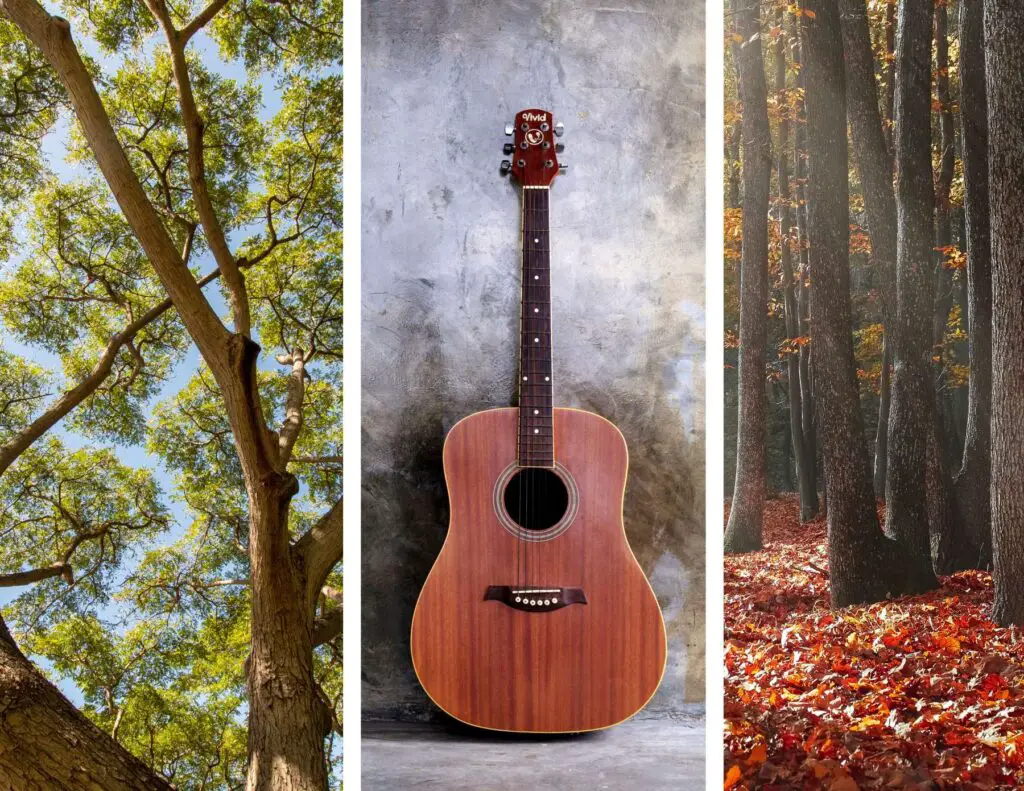
Final Thoughts
Acoustic guitars are truly a work of art: the choice and combination of different woods can drastically change its tone, volume, and even suitability for certain genres.
For example, spruce offers balance and clarity while mahogany provides warmth with complexity; cedar adds extra responsiveness but rosewood gives richer tones overall.
By taking into consideration each type’s unique sonic qualities when purchasing or constructing an acoustic guitar, players can make sure they get exactly what their music deserves!
